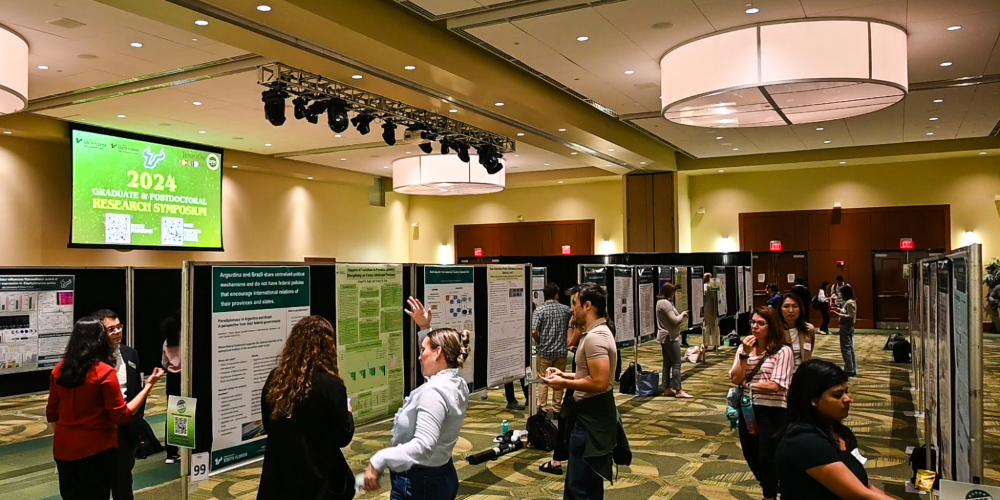The Graduate Student Research Symposium, jointly hosted by the Office of Graduate Studies and the Graduate and Professional Student Council (GPSC), serves as a platform for graduate students across disciplines to present their research and receive valuable feedback from faculty and peers. This event facilitates academic collaboration by bringing together graduate students, postdoctoral scholars, faculty mentors, and judges. Among the standout participants are two geosciences graduate students, whose winning abstracts and posters are showcased below. Additionally, both winners were honored with travel awards in recognition of their achievements.
Sunhye Kim – 2024 Graduate Research Symposium Winner - Poster
Major Professor: Patricia Spellman
Title: Identifying Causes of Water Chemistry Changes at Springs in an Eogenetic Karst Aquifer
Abstract: Northern Florida has been an area of intensive agricultural activity over the last
several decades which has degraded
water quality at springs draining the Upper Floridan Aquifer (UFA). Row crop and livestock
operations have affected
spring water quality by increasing nitrate concentrations, and possibly disrupting
major ion covariance. Additionally,
pumping from agriculture and industry have potentially lowered local hydraulic heads
which could increase flow from the
more evaporitic and dolomitic Lower Floridan Aquifer (LFA) via fractures, or alter
the contributing flow paths to springs.
Increases in specific conductance and major ions apart from nitrate have been observed
at springs across the UFA, and
the consequences of these additional changes are unclear. Because the causes would
be a result of different actions
(i.e., pumping vs surface operations), mitigating future changes requires different
strategies. As spring ecosystems
respond negatively to water quality degradation, it is important to identify causes
for effective spring restoration.
We report on preliminary results at Fanning Springs, a first magnitude spring where
water quality has been steadily
declining. We collected sulfur (δ34S) and oxygen (δ18O) isotopes of sulfate (SO42-),
major ions, organics, and water
isotopes at the spring and shallow wells in agriculturally impaired for a comprehensive
geochemical analysis of causes of
water quality disruption. Specific conductance at Fanning Spring almost exceeds what’s
expected of natural limestone
weathering indicating flow path changes are not the sole cause. A substantial depletion
of δ34S similar to locally
analyzed fertilizers suggests remaining water quality changes are likely from agricultural
surface applications.
Erica Fancher – 2024 Graduate Research People’s Choice Award - POSTER
Major Professor: Aurelie Germa
Title: Geochemical and textural investigations of pyroclastic products from the June 3rd
2018 eruption of Volcán de Fuego,
Guatemala
Abstract: The June 3rd, 2018, eruption of Fuego volcano (Guatemala) produced a complex sequence
of small-volume pyroclastic
density currents (PDCs) that inundated all sectors around the volcano and propagated
>12 km on the southeastern flank,
deposited ~50 million m3 of pyroclastic material.
The eruptive stratigraphy shows evidence of a sub-Plinian phase associated with tephra
fallout and one PDC unit
followed by at least seven stacked, massive flow units deposited by rapid stepwise
aggradation of successive block-and-
ash flow (BAF) pulses in the Las Lajas barranca on the southeastern flank.
This study investigates textural and geochemical changes throughout the June 3rd eruptive
sequence. Using component
analyses, juvenile clasts (scoria and glass) from each eruptive unit were selected
for major and trace element analyses,
bulk density calculation, and for quantification of vesicularity. The objectives are
to compare the characteristics of the
sub-Plinian and PDC phases to explain the changes in eruption dynamics.
Thin sections of representative juvenile material were imaged with a digital microscope
and a SEM, and processed using
the FOAMS software (Shea et al., 2010). Results show that sample have between 8 –
25% of bubbles. Following the
method of Toramaru (2006), decompression rates using bubble number density were obtained
for each unit. Whole rock
major and trace elements will be used to track changes in magma composition during
the eruption
